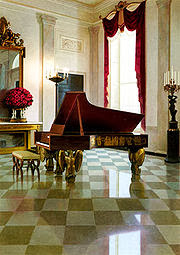In Review--piano de flamenco
Missing image
Diego Amador
rio de los canasteros
World Village
The first time I saw jazz-flamenco fusion piano was when I watched the Latin music documentary Calle 54 several years ago. I found Spanish jazz pianist Chano Dominguez's flamenco fusion breathtaking. The next time I heard piano performed on a flamenco recording was on a piece by Estrella Morente where she sang over solo piano. Again, I found the inclusion of piano on a flamenco piece stunning, even amazingly beautiful.
The multi-instrumentalist and vocalist Diego Amador also marries jazz and flamenco piano. But he does not just play piano on his CD rio de los canasteros, he also plays guitar, sings, and plays bass. It's not so far-fetched that he would eventually fuse Latin jazz with Andalusian music. His first musical stint while he was still a child, was playing drums for his older brothers' flamenco-rock band, while honing his talents on piano and other instruments.
His first CD on the World Village label, Piano Jondo collected praise from all of the right places. He returned with another fiery album that includes such luminaries as flamenco guitarist Tomatito, a proponent of nuevo tango and flamenco diva La Susi, as well as, his brother Raimundo, bassist Carles Benavent and Argentine guitarist Luis Salinas.
This album includes only nine tracks. While all of the tracks feature top-notch performances, it is the track, Al Latin which concludes the album that has left the greatest impression on me.
So those of you reading this might wonder how is flamenco music healing? It helps to release pent up emotion without the dangerous back beat found in rock music. It bridges gypsy, Arabic and other cultures through music. Similar to classical music, this genre also includes its array of virtuosos whose performances are simply breathtaking and magical. Often you hear of this cathartic place called duende which you just have to experience. It is a music full of passion, beauty, pain, and transcendence.
To me, flamenco music recalls Beethoven's symphonies, particularly the 5th Symphony. This music also releases anger, frustration and emotions we tend to stuff under a rug and pretend don't exist. With both the Beethoven and flamenco experience, there is nowhere to hide. Sensitive listeners realize that and face the darkness inside themselves as well as, wounds and eventually come out the other side of the musical experience, cleanses and renewed.
worldvillagemusic.com
Diego Amador
rio de los canasteros
World Village
The first time I saw jazz-flamenco fusion piano was when I watched the Latin music documentary Calle 54 several years ago. I found Spanish jazz pianist Chano Dominguez's flamenco fusion breathtaking. The next time I heard piano performed on a flamenco recording was on a piece by Estrella Morente where she sang over solo piano. Again, I found the inclusion of piano on a flamenco piece stunning, even amazingly beautiful.
The multi-instrumentalist and vocalist Diego Amador also marries jazz and flamenco piano. But he does not just play piano on his CD rio de los canasteros, he also plays guitar, sings, and plays bass. It's not so far-fetched that he would eventually fuse Latin jazz with Andalusian music. His first musical stint while he was still a child, was playing drums for his older brothers' flamenco-rock band, while honing his talents on piano and other instruments.
His first CD on the World Village label, Piano Jondo collected praise from all of the right places. He returned with another fiery album that includes such luminaries as flamenco guitarist Tomatito, a proponent of nuevo tango and flamenco diva La Susi, as well as, his brother Raimundo, bassist Carles Benavent and Argentine guitarist Luis Salinas.
This album includes only nine tracks. While all of the tracks feature top-notch performances, it is the track, Al Latin which concludes the album that has left the greatest impression on me.
So those of you reading this might wonder how is flamenco music healing? It helps to release pent up emotion without the dangerous back beat found in rock music. It bridges gypsy, Arabic and other cultures through music. Similar to classical music, this genre also includes its array of virtuosos whose performances are simply breathtaking and magical. Often you hear of this cathartic place called duende which you just have to experience. It is a music full of passion, beauty, pain, and transcendence.
To me, flamenco music recalls Beethoven's symphonies, particularly the 5th Symphony. This music also releases anger, frustration and emotions we tend to stuff under a rug and pretend don't exist. With both the Beethoven and flamenco experience, there is nowhere to hide. Sensitive listeners realize that and face the darkness inside themselves as well as, wounds and eventually come out the other side of the musical experience, cleanses and renewed.
worldvillagemusic.com



Comments
Post a Comment